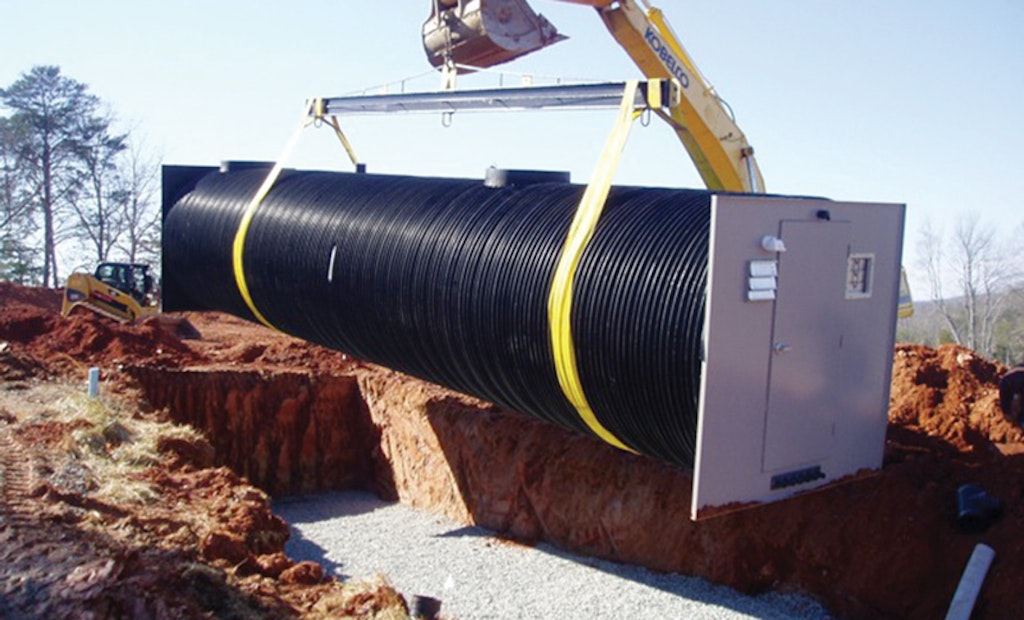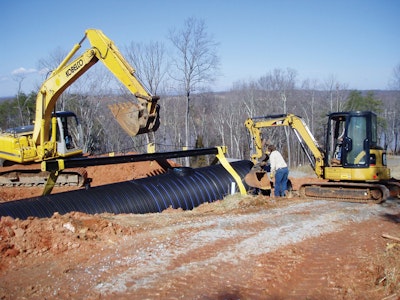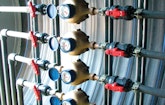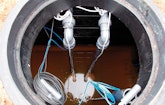
Interested in Alarms/Controls?
Get Alarms/Controls articles, news and videos right in your inbox! Sign up now.
Alarms/Controls + Get AlertsOptima Properties wanted to build a private waterfront community at Smith Mountain Lake in Union Hall, Va., and commissioned Dan Early, P.E., of ACS DESIGN in Roanoke, Va., to design a decentralized wastewater treatment system. Bidding on the project was by invitation only.
Emmett Mitchell of Chaffin Excavating in Bedford, Va., won the bid to install the pump station and drainfields. “I had the option of installing concrete tanks for the pumps, a utility vault with flowmeters and valves, and splitter box or using PumpMaxx, a packaged pump station,” he says. “I bid on just the vessel, because I’d installed them before and knew how much time and labor they saved.”
Early estimated four weeks to install the conventional method. Mitchell installed the pump vessel in less than one week, and finished the drainfield ahead of schedule despite some heavy rains and late-winter snow.
Site conditions
Soils are sandy loam with a percolation rate of 0.6 inches per hour. The community is in the southwestern Blue Ridge Mountains.
System components
Early designed the system to handle 52,590 gpd. Only three of nine drainfields have been installed, totaling 16,200 gpd for 32 single-family homes. Other drainfields will be installed as necessary. Major components are:
- 32 1,000-gallon, two-compartment concrete septic tanks. All tanks from C.T. Jamison, Callaway, Va.
- 32 MicroFAST 0.5 (500 gpd) treatment systems (Bio-Microbics) with air pump (HiBlow USA)
- 32 1,000-gallon, two-compartment nitrification tanks with 1 hp septic tank effluent pump (STEP) systems and UV disinfection (Polylok)
- 32 Titan simplex control panels (CSI Controls)
- PumpMaxx HE packaged pump station (AppTech Solutions) with duplex 1.5 hp high-head pumps (Myers)
- 2,700 feet of 4-inch leach bed pipe (Advanced Drainage Systems)
System operation
Subcontractors install onsite components as homes are built.
The STEP systems, which eliminate the need for large lift stations, pump liquid through 3-inch low-pressure force mains to the pump station, an 8-foot-diameter by 40-foot-long steel-reinforced polyethylene vessel. A pressure-sensing transducer signals the programmable logic controller to activate the on-demand alternating pumps in the 998-cubic-foot wet well. A cycle distributes 69.4 gpm through a valved and metered 4-inch manifold to 1.5-inch force mains dosing each drainfield per capacity: Drainfield A at 4,200 gpd, B at 4,800 gpd, and C at 7,200 gpd, all with 100-foot-long laterals. The wet well has emergency float switches should the transducer fail.
“We have used this disposal method for more than 10 years on numerous mass drainfields,” says Scott Easter, P.E., of ACS. “It is extremely reliable, easy to calibrate for changing conditions, and an excellent total disposal volume monitoring tool.” The pump station can be customized to fit any project requirements.
Valves, instrumentation and controls are in a 10-foot equipment room at the front of the vessel. The rack-mounted control panel includes a main breaker, pump electrical controls and pump station level control.
Installation
Two days before the 8,000-pound pump station arrived, Mitchell, machine operator Daniel Johnson, and a laborer dug a 46- by 14-foot-wide hole in the side of a hill using a Case 580 Super L backhoe. “The upper end of the excavation was 8 feet deep and the toe with the door to the equipment room was 2 feet deep,” says Mitchell. “We also recessed under the door so it would drain like a walkout basement.” He locked a community security gate each night to prevent curious people from driving up to look around.
Gary Mayhew of Gary Mayhew Excavating in Bedford transported the pump station 1,800 feet up the hill with his Kobelco 210 tracked excavator. “The tank is bulky, but lightweight enough that we could use wide straps and spreader bars to lift and set it,” says Mitchell. The vessel sits on square flanges, one per end, on 8 inches of compacted gravel.
The crew built a drainage system of 6-inch perforated pipe around the vessel for buoyancy resistance, then teed the drain to an 8-inch solid pipe running to daylight. They double insulated the six 1.5-inch Schedule 80 PVC force main stub outs in front of the door with fiberglass pipe wrap, then laid fiberglass batts on top of them. The area has an 18-inch frost line.
Before bedding to the haunch of the tank and backfilling, the team poured a 4-foot-square by 4-inch-thick concrete pad by the door. “I’m always tickled by how easy it is to install these units,” says Mitchell. “We dig one hole. All the connections are there. It’s a no-brainer.”
Mitchell used the excavate-and-drag technique to install the 36-inch-wide stone-and-pipe trenches, all on 9-foot centers. Drainfield A had seven laterals 7 feet deep, B had eight laterals 7.5 feet deep, and C had 12 laterals 8 feet deep. To keep workers out of the trenches, Mitchell used a drag box. “It provided a safe, rapid means of depositing the 4-inch-deep gravel bed and laying the pipe on top of it,” he says.
Using the backhoe, Johnson excavated a space in the trench for the drag box, while Mitchell connected a 100-foot roll of tubing to the feed mechanism in the structure. After setting it, Billie Joe Creasey used a Caterpillar 279C compact track loader to fill the box with stone and kept it full as Johnson excavated and pulled the unit forward. A banksman shot grades throughout the operation and prevented the tubing from kinking as it unrolled.
The team completed 400 feet per day, covering the pipe with 4 inches of gravel, a filter fabric and backfilling. “We installed only as much as could be inspected and rough covered in one day,” says Mitchell. “February brought some snow and heavy rains, and we would never endanger a drainfield by allowing it to get wet.”
The crew also plumbed the force mains to the remaining drainfields. “If I wasn’t awarded the bid to install those beds, I didn’t want another contractor’s equipment rumbling around and tearing up what we’d done,” says Mitchell. “We left the lines clearly marked and ready for easy hookup.”
Maintenance
Petrus Environmental Services in Roanoke maintains the pump station. In case of an electrical failure, a main breaker shuts off the power, enabling a technician to run the emergency generator.









